theartsdesk at the Haapsalu Early Music Festival 2024 - other-worldly instruments, perfect programmes and haunting venues | reviews, news & interviews
theartsdesk at the Haapsalu Early Music Festival 2024 - other-worldly instruments, perfect programmes and haunting venues
theartsdesk at the Haapsalu Early Music Festival 2024 - other-worldly instruments, perfect programmes and haunting venues
A world-class gem, now in its 31st year, in an Estonian seaside glory of a town
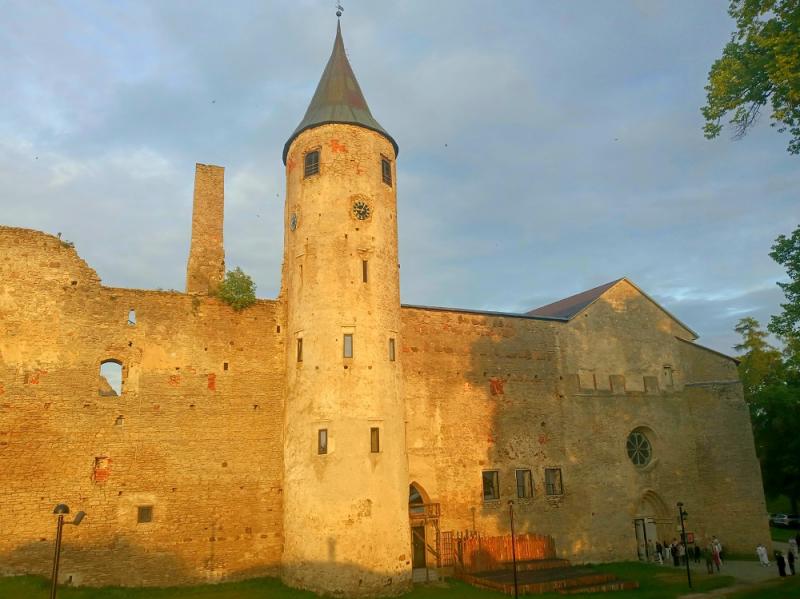
The buildings, 13th-16th century, are earlier than the music (mostly Baroque). And what buildings. Non-Estonians like myself had heard that Haapsalu was a fine seaside town; but tourist publicity neglected the glory of the castle and cathedral, a central festival venue. If Livonians, Germans, Swedes and Russians all passed through, enriching and destroying, this most perfect of small festivals now welcomes international musicians to perform alongside world-class Estonians.
Since musicologist, conductor and Artistic Director Toomas Siitan founded the festival in 1994, making it one of the oldest in the Republic of Estonia, the star quota has steadily risen: it was countertenor Iestyn Davies, a sensation here last year, who thought I might love the place as much as he did and made a recommendation. Stephen Layton (pictured below) wasn't the big name in the music world he is now when he appeared at the second festival, but this year he returned trailing clouds of glory and powered the most uplifting work imaginable for the opening concert, Handel's Israel in Egypt.  Resonant but not too swimmy in the much-restored but simply presented Cathedral, the biggest single-nave building in the Baltics and the only sanctuary space of its kind to keep its original structure, the forces were impeccable. The Haapsalu Festival Baroque Orchestra led by distinguished Finnish violinist Minna Kangas and the Tumult Ensemble, yet another remarkable Tallinn-based chamber choir, set up by Dutchman Lodewijk van der Ree, blazed and rumbled in the curiously-told legend of plagued Egyptians and ultimately liberated Israelites (note: harpsichordist Saale Fischer, who played in this and the following evening's concert, is the festival's vivacious General Manager).
Resonant but not too swimmy in the much-restored but simply presented Cathedral, the biggest single-nave building in the Baltics and the only sanctuary space of its kind to keep its original structure, the forces were impeccable. The Haapsalu Festival Baroque Orchestra led by distinguished Finnish violinist Minna Kangas and the Tumult Ensemble, yet another remarkable Tallinn-based chamber choir, set up by Dutchman Lodewijk van der Ree, blazed and rumbled in the curiously-told legend of plagued Egyptians and ultimately liberated Israelites (note: harpsichordist Saale Fischer, who played in this and the following evening's concert, is the festival's vivacious General Manager).
Coming as it does between two other masterpieces, Saul and Messiah, Israel in Egypt is an anomaly in that choruses predominate, solos and duets are minimal. Drawn from the chorus, not all the soloists were ideally confident – it might be unfair to judge from relatively far back in the cathedral – but the stars here were basses Janari Jorro and Andreas Väljamäe in "The Lord is a man of war", intensifying the general splendour. But Layton's overall shaping impressed at every turn, from the great blazes to the deeply moving reflection of "The people shall hear, and be afraid". Some thought it romantic; surely it was just deeply human and expressive, alive to all of Handel's drama-at-one-remove. 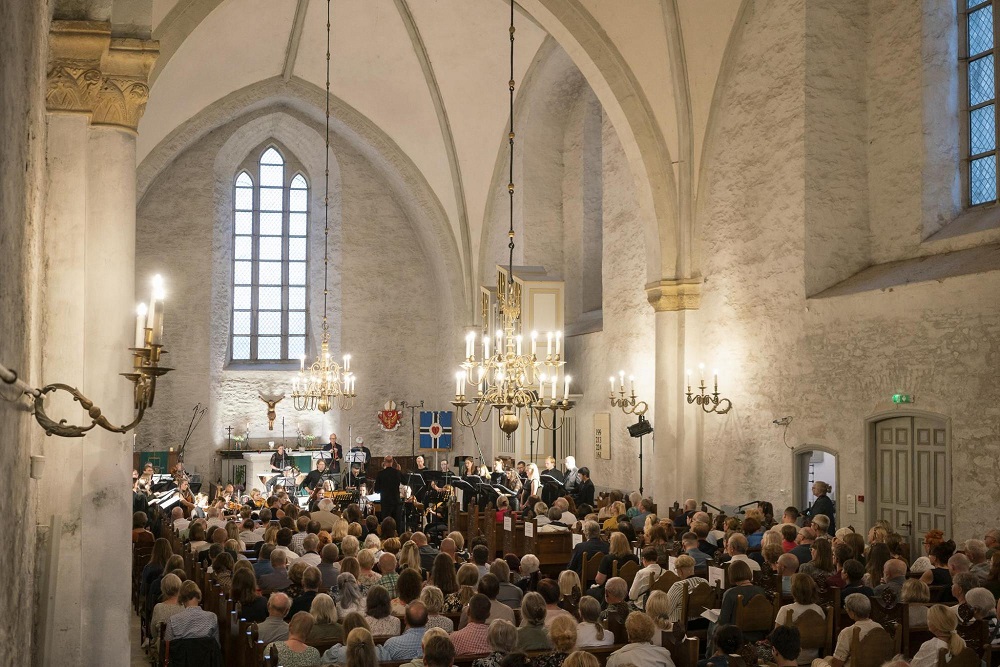 The daily pattern allowed for full exploration of Haapsalu, with its mixture of coast and swimming-friendly lake, its abundance of museums. The castle has been spectacularly well restored to include walkways and immaculately presented displays within the walls and the crypt; Estonians were envious that I got to the newly-reopened gallery housing the works of Ewald Okas (1915-2011), a fine group portraitist and better than the tarnishing of his going along with the Soviet regime might suggest. Seafront promenades could be disconcerting; temperatures had risen, and thousands of dead tiny fish, deprived of oxygen, lined the shores. But the wooden buildings are even more beautiful than in Pärnu further down the coast, and the main afternoon venue of the festival, St John's Lutheran Church, is instantly lovable, flooded with light and graced with beautiful furnishings, above all its stone-carved altar relief.
The daily pattern allowed for full exploration of Haapsalu, with its mixture of coast and swimming-friendly lake, its abundance of museums. The castle has been spectacularly well restored to include walkways and immaculately presented displays within the walls and the crypt; Estonians were envious that I got to the newly-reopened gallery housing the works of Ewald Okas (1915-2011), a fine group portraitist and better than the tarnishing of his going along with the Soviet regime might suggest. Seafront promenades could be disconcerting; temperatures had risen, and thousands of dead tiny fish, deprived of oxygen, lined the shores. But the wooden buildings are even more beautiful than in Pärnu further down the coast, and the main afternoon venue of the festival, St John's Lutheran Church, is instantly lovable, flooded with light and graced with beautiful furnishings, above all its stone-carved altar relief.
Some of the happiest musical hours ever, for me, at any rate, started here with a winning partnership. Taavi Kerikmäe was demonstrating for the first time the cembal d'amour, built this year by Latvian instrument maker Kaspars Putriņš on designs for a very significant 1721 model, and his partner Anna-Liisa Eller played no less than two Estonian kannels, arpanetta and psaltery.  Kerikmäe is a real thinker and performer outside the box, running the gamut from early music to electronics. I hadn't realised until I returned that he was the curator of the life-changing two-hour blindfold event at the 2017 Estonian New Music Days. Here he and Eller collaborated on reviving the works of composer, organist, poet and music scholar David Kellner (c.1670-1748), German-born but educated at the great Tartu University, keen in his last years to return to take up a post there. The "new" instrument reborn here is connected to Kellner's step-daughter Regina Gertrud König, nominally Estonia's first woman composer, though none of her works has been unearthed as yet. It was she who commissioned the cembal d'amour, almost as quiet as a clavichord but capable of infinite gradations within its soft dynamic spectrum; the same can be said of Eller's artistry, taking folk instruments and adapting them to the classical-music repertoire.
Kerikmäe is a real thinker and performer outside the box, running the gamut from early music to electronics. I hadn't realised until I returned that he was the curator of the life-changing two-hour blindfold event at the 2017 Estonian New Music Days. Here he and Eller collaborated on reviving the works of composer, organist, poet and music scholar David Kellner (c.1670-1748), German-born but educated at the great Tartu University, keen in his last years to return to take up a post there. The "new" instrument reborn here is connected to Kellner's step-daughter Regina Gertrud König, nominally Estonia's first woman composer, though none of her works has been unearthed as yet. It was she who commissioned the cembal d'amour, almost as quiet as a clavichord but capable of infinite gradations within its soft dynamic spectrum; the same can be said of Eller's artistry, taking folk instruments and adapting them to the classical-music repertoire.
A full programme of Kellner's lute pieces in their original reform might be too much of a good thing; there are light and spirit here, but he's no Bach (who is?) By presenting the strands so well – Kerikmäe checked how many non-Estonian speakers there were in the audience and summarised for us brilliantly – and ringing the changes on the arrangements the two had made, the duo assured our full attention throughout. The key of A major seemed to win a special radiance from Kellner. There was humour here too: when the composer makes a cuckoo go wrong, Eller wryly tried to correct Kerikmäe's unnatural deviation. Definitely a case where two players and six instruments – Kerikmäe' also switched to another clavichord – were better than one.  His full exposition the following afternoon in a balmy summer residence closer to the sea, the Lahe Guesthouse, enriched the experience still further. We also had the quirky contribution of maker Putriņš, drawn out charmingly by Kerikmäe to give us more chapter and verse. An encyclopaedic experience that really merits a full piece by itself.
His full exposition the following afternoon in a balmy summer residence closer to the sea, the Lahe Guesthouse, enriched the experience still further. We also had the quirky contribution of maker Putriņš, drawn out charmingly by Kerikmäe to give us more chapter and verse. An encyclopaedic experience that really merits a full piece by itself.
Two more evening concerts back in the Cathedral showed respectively how to continue the skill of programming, and how not to do it. I'd not previously encountered leader and mastermind of the Finnish Baroque Orchestra, Anthony Marini: as his entrance from the side of the nave playing Westhoff's bell-imitating Sonata No. 3 proved, he's as live a wire as his compatriot Pekka Kuusisto, and filled the big space with resonant sound. 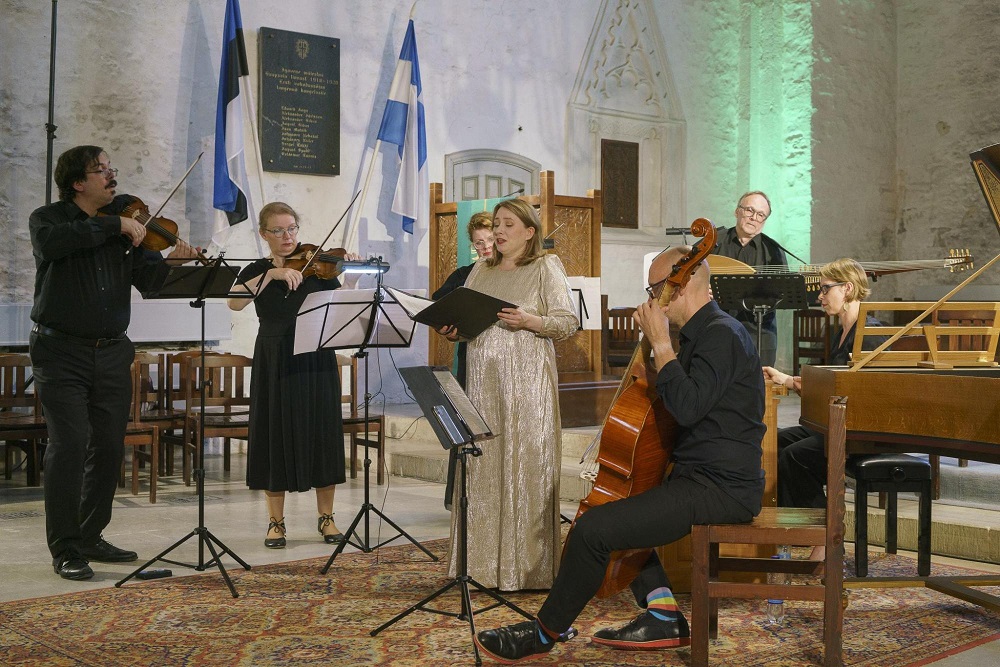 The skill was to interweave instrumental works with contributions from soprano Maria Valdmaa of the Tallinn group Floridante, whose players shared the honours with members of FiBO. The Schutz pieces were all stylishly sung, but Valdmaa's voice was under stress by the time of the extended finale, Buxtehude's "Herr, wenn ich nur dich habe". The ideal flow at which this festival seems so good was never in doubt.
The skill was to interweave instrumental works with contributions from soprano Maria Valdmaa of the Tallinn group Floridante, whose players shared the honours with members of FiBO. The Schutz pieces were all stylishly sung, but Valdmaa's voice was under stress by the time of the extended finale, Buxtehude's "Herr, wenn ich nur dich habe". The ideal flow at which this festival seems so good was never in doubt.
Spain's La Grande Chapelle (pictured below) was the odd group out. Not because the six singers directed by Albert Recasens were anything less than phenomenal in giving us full-throated polyphony; but a little Victoria, for me, goes a long way. It's a joy to sing, I know, but where's the individuality? If you asked AI to produce a Renaissance mass, would it be any different? The point is that the Missa "Vidi speciosam" is always worth hearing; but could the sequence of motets that followed it really be justified? The hardcore would probably say yes, but as a sequence, this didn't have the necessary contrasts.  You can never go wrong with a full programme of Bach, on any combination, so long as the artistry is there. As it was, in combination with further education about the art of rich and strange instruments, in the afternoon concert presented by La Tasteggiata's personable alto-nyckelharpist Marco Ambrosini (pictured below with Eller).
You can never go wrong with a full programme of Bach, on any combination, so long as the artistry is there. As it was, in combination with further education about the art of rich and strange instruments, in the afternoon concert presented by La Tasteggiata's personable alto-nyckelharpist Marco Ambrosini (pictured below with Eller).
So what's a nyckelharp? In short, a bowed instrument with sympathetic strings of Swedish origin where the pitch is changed using a keyboard. It's quite a sight, and had probably fallen out of use by Bach's heyday, but more vitally, produces a rich and resonant sound, a bit like an amplified viola d'amore in the case of Ambrosini senior's instrument. Angela Ambrosini plays the soprano version, Valentin Cointet the bass – a rich trio indeed (pictured below), but further enhanced here by harpsichordist Eva-Maria Rusche and the return of Anna-Liisa Eller. Individual moments in the sun, like the surprisingly big sound Eller could draw from her kannel in the E major Invention BWV 777 and movements of the Lute Suite No. 2 in C minor were offset by moments of collective joy (the pinnacle surely the E flat major Invention BWV 776). The good news is that a recording has been made for ECM, a chance to digest these riches at leisure.
Angela Ambrosini plays the soprano version, Valentin Cointet the bass – a rich trio indeed (pictured below), but further enhanced here by harpsichordist Eva-Maria Rusche and the return of Anna-Liisa Eller. Individual moments in the sun, like the surprisingly big sound Eller could draw from her kannel in the E major Invention BWV 777 and movements of the Lute Suite No. 2 in C minor were offset by moments of collective joy (the pinnacle surely the E flat major Invention BWV 776). The good news is that a recording has been made for ECM, a chance to digest these riches at leisure. 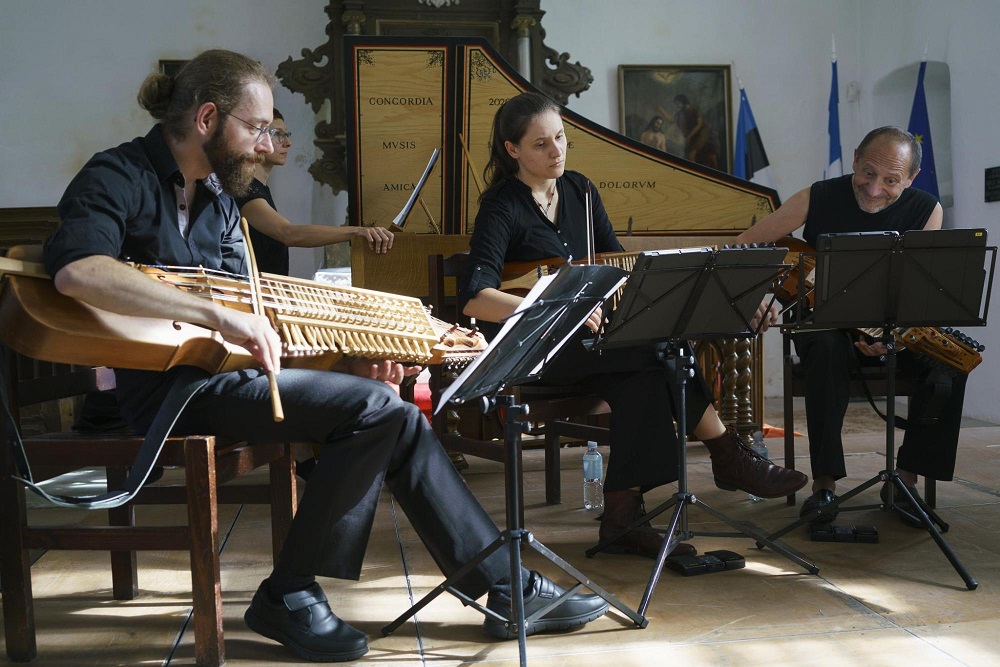 One last event in St John's Church when the intense afternoon sun had given way to imminent stormy weather continued the trend of light and charm. The Tro Sfacciato consists of two Estonians, violinist Lisanne Altrov and harpsichordist Piibe Maria Talen, and German cellist Hannah Stoeliger (pictured below). Vibrancy was the immediate impression made in Isabella Leonarda's Sonata No. 12 before the strings went solo.
One last event in St John's Church when the intense afternoon sun had given way to imminent stormy weather continued the trend of light and charm. The Tro Sfacciato consists of two Estonians, violinist Lisanne Altrov and harpsichordist Piibe Maria Talen, and German cellist Hannah Stoeliger (pictured below). Vibrancy was the immediate impression made in Isabella Leonarda's Sonata No. 12 before the strings went solo.
When does Biber not stand out in a Baroque programme for his sheer originality, given top musicianship? Marini had emphasised the eccentricity of the Second Violin Sonata on Friday evening; Altrov soared in the Seventh Sonata. Perhaps the only fall in temperature came from Talen in Bach's C minor Partita No. 2; Eller and company had set insanely high standards the previous afternoon. Yet it was still a happy continuity of the Estonian strand running through most of the performances. 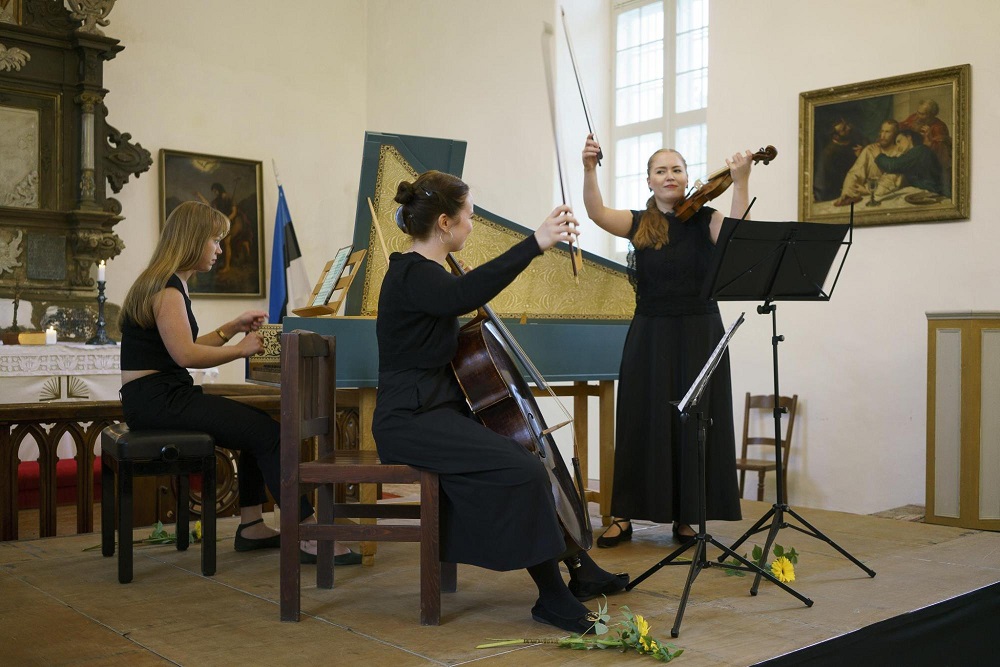 Earlier that afternoon the printed programme of a showcase for young players from 9 to 19 who'd gathered for the short Early Music Summer School, held for the past two years in Haapsalu, occasioned an incipient dread: 24 pieces seemed like a lot to get through. I shouldn't have worried; the whole event was impeccably presented, with fluent stand changes and neat bows before and after from every performer. And what an achievement to mix the offspring of musical families – some harpsichordists involved, I gather, – with others who were simply learning to play together for the first time.
Earlier that afternoon the printed programme of a showcase for young players from 9 to 19 who'd gathered for the short Early Music Summer School, held for the past two years in Haapsalu, occasioned an incipient dread: 24 pieces seemed like a lot to get through. I shouldn't have worried; the whole event was impeccably presented, with fluent stand changes and neat bows before and after from every performer. And what an achievement to mix the offspring of musical families – some harpsichordists involved, I gather, – with others who were simply learning to play together for the first time.
There were plenty of surprises: it wasn't always the youngest who faltered, though clearly the wisdom of teaching each player to move on if he or she made a mistake had paid off. And the atmosphere was one of a festival, not a competition, with brothers and sisters as well as parents in the audience focused from start to finish. There were two standouts: a nine-year old cellist, Dylan Scuffham, and a beaming all-rounder who showed individuality in everything she did, Irene Reinman (the two in the group pictured below seated left and middle).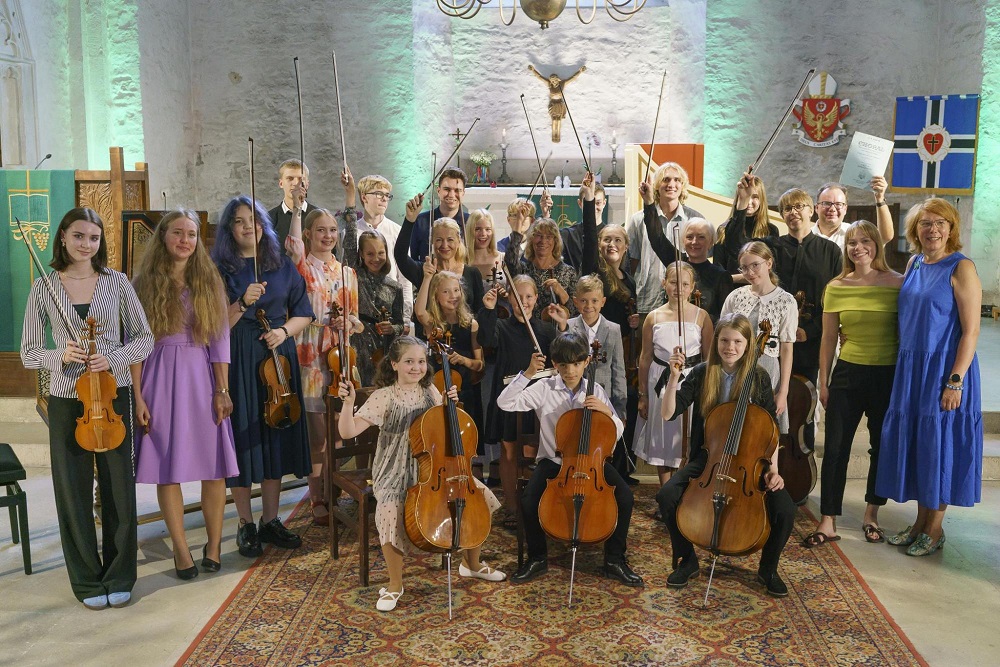 The young instrumentalists' finale was a joyous group effort, duly encored. The end of the festival proper was smaller-scale than the jubilant launch, but kept the spirits soaring with the brilliant leadership of Marini, winning true teamwork alongside five other Finnish Baroque Orchestra soloists. The theme of "Crossing Borders", apt for a conspicuously pan-European festival, gave us a Telemann Concerto robustly "alla Polonese" followed by Couperin's fascinating Apotheosis of Corelli, especially remarkable in the flowing music for the Parnassian source of the Hypocrene from which the great man drinks to be reborn.
The young instrumentalists' finale was a joyous group effort, duly encored. The end of the festival proper was smaller-scale than the jubilant launch, but kept the spirits soaring with the brilliant leadership of Marini, winning true teamwork alongside five other Finnish Baroque Orchestra soloists. The theme of "Crossing Borders", apt for a conspicuously pan-European festival, gave us a Telemann Concerto robustly "alla Polonese" followed by Couperin's fascinating Apotheosis of Corelli, especially remarkable in the flowing music for the Parnassian source of the Hypocrene from which the great man drinks to be reborn.
It was an inspired idea to contrast Scottish rhapsodies by Geminiani and Veracini (the A major Sonata, purest delight) with The Art of Fugue's Contrapuncti 1, 13 and 6 (in stile Francese): the change of tone colour here showed the art of a very fine string group indeed. Mixing it all up still further, the festivities ended with pure exuberance in Italian-born Krishna Nagaraja's arrangements, a la Danish String Quartet, of Finnish/Lapp folk music. The fault-lines of the new(ish) Europe may be showing, but not in the musical world, and Estonia – a small country which, a few wobbles apart, has shown us the EU ideal can be realised – is the right place for all this.
Explore topics
Share this article
The future of Arts Journalism
You can stop theartsdesk.com closing!
We urgently need financing to survive. Our fundraising drive has thus far raised £49,000 but we need to reach £100,000 or we will be forced to close. Please contribute here: https://gofund.me/c3f6033d
And if you can forward this information to anyone who might assist, we’d be grateful.

Subscribe to theartsdesk.com
Thank you for continuing to read our work on theartsdesk.com. For unlimited access to every article in its entirety, including our archive of more than 15,000 pieces, we're asking for £5 per month or £40 per year. We feel it's a very good deal, and hope you do too.
To take a subscription now simply click here.
And if you're looking for that extra gift for a friend or family member, why not treat them to a theartsdesk.com gift subscription?
more Classical music
 Robin Holloway: Music's Odyssey review - lessons in composition
Broad and idiosyncratic survey of classical music is insightful but slightly indigestible
Robin Holloway: Music's Odyssey review - lessons in composition
Broad and idiosyncratic survey of classical music is insightful but slightly indigestible
 Classical CDs: Wolf-pelts, clowns and social realism
British ballet scores, 19th century cello works and contemporary piano etudes
Classical CDs: Wolf-pelts, clowns and social realism
British ballet scores, 19th century cello works and contemporary piano etudes
 Bizet in 150th anniversary year: rich and rare French offerings from Palazzetto Bru Zane
Specialists in French romantic music unveil a treasure trove both live and on disc
Bizet in 150th anniversary year: rich and rare French offerings from Palazzetto Bru Zane
Specialists in French romantic music unveil a treasure trove both live and on disc
 Scottish Chamber Orchestra, Ibragimova, Queen’s Hall, Edinburgh review - rarities, novelties and drumrolls
A pity the SCO didn't pick a better showcase for a shining guest artist
Scottish Chamber Orchestra, Ibragimova, Queen’s Hall, Edinburgh review - rarities, novelties and drumrolls
A pity the SCO didn't pick a better showcase for a shining guest artist
 Kilsby, Parkes, Sinfonia of London, Wilson, Barbican review - string things zing and sing in expert hands
British masterpieces for strings plus other-worldly tenor and horn - and a muscular rarity
Kilsby, Parkes, Sinfonia of London, Wilson, Barbican review - string things zing and sing in expert hands
British masterpieces for strings plus other-worldly tenor and horn - and a muscular rarity
 From Historical to Hip-Hop, Classically Black Music Festival, Kings Place review - a cluster of impressive stars for the future
From quasi-Mozartian elegance to the gritty humour of a kitchen inspection
From Historical to Hip-Hop, Classically Black Music Festival, Kings Place review - a cluster of impressive stars for the future
From quasi-Mozartian elegance to the gritty humour of a kitchen inspection
 Shibe, LSO, Adès, Barbican review - gaudy and glorious new music alongside serene Sibelius
Adès’s passion makes persuasive case for the music he loves, both new and old
Shibe, LSO, Adès, Barbican review - gaudy and glorious new music alongside serene Sibelius
Adès’s passion makes persuasive case for the music he loves, both new and old
 Anja Mittermüller, Richard Fu, Wigmore Hall review - a glorious hall debut
The Austrian mezzo shines - at the age of 22
Anja Mittermüller, Richard Fu, Wigmore Hall review - a glorious hall debut
The Austrian mezzo shines - at the age of 22
 First Person: clarinettist Oliver Pashley on the new horizons of The Hermes Experiment's latest album
Compositions by members of this unusual quartet feature for the first time
First Person: clarinettist Oliver Pashley on the new horizons of The Hermes Experiment's latest album
Compositions by members of this unusual quartet feature for the first time
 Gesualdo Passione, Les Arts Florissants, Amala Dior Company, Barbican review - inspired collaboration excavates the music's humanity
At times it was like watching an anarchic religious procession
Gesualdo Passione, Les Arts Florissants, Amala Dior Company, Barbican review - inspired collaboration excavates the music's humanity
At times it was like watching an anarchic religious procession
 Classical CDs: Camels, concrete and cabaret
An influential American composer's 90th birthday box, plus British piano concertos and a father-and-son duo
Classical CDs: Camels, concrete and cabaret
An influential American composer's 90th birthday box, plus British piano concertos and a father-and-son duo
 Cockerham, Manchester Camerata, Sheen, Martin Harris Centre, Manchester review - re-enacting the dawn of modernism
Two UK premieres added to three miniatures from a seminal event of January 1914
Cockerham, Manchester Camerata, Sheen, Martin Harris Centre, Manchester review - re-enacting the dawn of modernism
Two UK premieres added to three miniatures from a seminal event of January 1914

Add comment